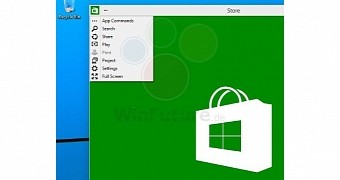The debut of Windows 9 preview is only a few weeks away, so it’s no surprise that so many details regarding the features to be part of this release are reaching the web on a daily basis.
Since it’s a brand new Windows version, it’s only natural to expect this product to come with a lot of changes, and people close to the matter indicated that Microsoft might actually remove all Metro features from the desktop and keep them exclusively available in the Modern UI.
The Charms bar was thus expected to get the axe, but according to previous speculation, this feature was believed to be removed completely from the operating system in favor of new buttons placed in the title bar of each app.
Now the leaked Windows 9 screenshots that reached the web yesterday provide us with more information on the “new” Charms bar, which still appears to be part of the upcoming operating system.
Charms now part of Metro apps
As you can see in the screenshot adjacent to the test, all charms are now available right in Modern apps, allowing users to perform pretty much the same tasks as before.
The biggest difference is that users now need to click a dedicated button in the title bar that allows them to search, share, play, print, project, or access settings. Previously, everyone had to swipe left from the right edge of the screen in order to launch the Charms bar.
Microsoft will also allow developers to implement charms in their apps to provide extended functionality, but it’s not yet clear whether doing this would be as easy as implementing code for the dedicated Charms bar currently available in Windows 8.1.
Windows Store apps could in the end get charms as part of a drop down menu, but it could take quite a lot of time until the most important programs currently available on Windows 8.1 are ported to Windows 9 with this new option.
Windows 9 to separate the desktop from the Modern UI
Microsoft is working to remove Modern UI elements from the desktop, so Windows 9 will come with a Start menu and basically no feature that would get users to the touch-optimized environment.
It will all depend on the device you use, however, as PCs, which still rely on a mouse and keyboard as the main input method, will get straight to the desktop, while tablets will still see the Start screen at boot.
The Start screen in its turn will also receive a number of improvements, including interactive live tiles that will allow users to perform a number of actions without directly launching the app.

 14 DAY TRIAL //
14 DAY TRIAL //